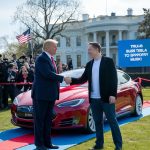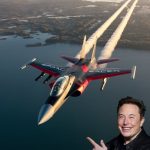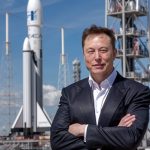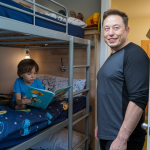Elon Musk’s Tesla Stock Plunge: A $4.4 Billion Hit and the Road Ahead

On April 9, 2025, Tesla’s stock (TSLA) took another hit, dropping 2.5% and wiping out $4.4 billion of Elon Musk’s personal wealth in a single day, according to Yahoo Finance. This latest tumble is part of a punishing year for Musk, whose net worth has reportedly plummeted by $134 billion since January 2025, driven by global trade disruptions and Tesla’s rocky performance. With the stock down 38% year-to-date, questions swirl about whether Musk can steer Tesla back to its former glory or if his empire is showing signs of deeper cracks. Let’s break down the factors at play, analyze the current sentiment, and offer a grounded prediction for Tesla’s future.
What Happened: The Numbers and Context
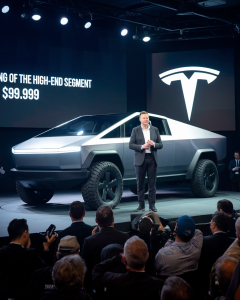
The April 9 drop saw Tesla’s stock close at $218.79, a sharp decline from its high of $488.54 earlier in the year. Musk’s wealth, heavily tied to his Tesla shares, took a direct hit, with the Bloomberg Billionaires Index pegging his net worth at $297.8 billion—still making him the world’s richest person, but with a shrinking lead. The $4.4 billion single-day loss is part of a broader $134.7 billion erosion in 2025, fueled by a volatile market and Tesla’s exposure to global trade tensions.
Musk didn’t stay silent. Taking to X, he pinned the blame on “market panic” and “short-sellers betting against Tesla’s long-term vision.” He doubled down on optimism, vowing to ramp up production and teasing a new U.S. gigafactory to bolster domestic manufacturing. However, analysts argue the root issues run deeper than market jitters, pointing to Tesla’s heavy reliance on its Shanghai Gigafactory, which exports EVs to Europe and Asia but is now caught in the crossfire of escalating U.S.-China trade wars.
Why Tesla’s Stock Is Tanking
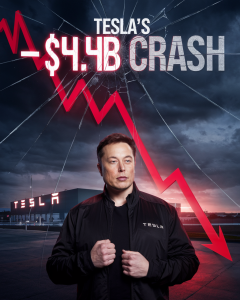
Several factors have converged to batter Tesla’s stock in 2025:
- Global Trade Disruptions
Tesla’s Shanghai factory, a cornerstone of its global supply chain, has been hit hard by trade wars. With Beijing slapping 125% tariffs on U.S. imports and Trump imposing steep duties on Chinese goods, Tesla faces rising costs and logistical headaches. The company’s Berlin Gigafactory also relies on EU-sourced components now subject to U.S. tariffs, squeezing margins further. These disruptions have led to production delays and a 13% drop in first-quarter deliveries, the weakest in nearly three years. - Brand Backlash and Sales Slump
Musk’s political alignment with the Trump administration, including his role as head of the Department of Government Efficiency (DOGE), has alienated some of Tesla’s core customer base—eco-conscious, progressive buyers. Protests against Musk’s far-right affiliations have flared in Europe and the U.S., with reports of vandalism and boycotts. In Norway, once a stronghold for Tesla, sales have cratered. Combined with a global slowdown in EV demand and fierce competition from China’s BYD, Tesla’s deliveries are under pressure. - Valuation Concerns
Tesla’s forward price-to-earnings (P/E) ratio remains sky-high—over nine times the average of major automakers and quadruple that of BYD. Investors like Ross Gerber argue the stock is “impossible to justify” at current levels, especially with 2025 delivery forecasts being slashed. Analysts at Barclays warn that Tesla faces a “challenging path” to even flat year-on-year volume growth, a far cry from Musk’s earlier 20-30% growth promise. - Musk’s Divided Focus
Musk’s sprawling empire—SpaceX, X, xAI, Neuralink, and now DOGE—has raised concerns about his bandwidth. Investors worry he’s not devoting enough time to Tesla, particularly as sales falter and competitors gain ground. His public spats, like calling Trump trade adviser Peter Navarro a “moron” over tariffs, haven’t helped calm nerves.
Musk’s Response: Doubling Down

Musk remains defiant. On X, he dismissed short-term losses as noise, emphasizing Tesla’s long-term potential in EVs, autonomy, and energy storage. His hint at a new U.S. gigafactory—potentially in Texas or a tariff-friendly state—suggests a pivot to insulate Tesla from global trade risks. Musk also pointed to upcoming products, like a refreshed Model Y and a $25,000 compact EV codenamed “Redwood,” set for mid-2025 production, as growth drivers. He’s banking on full self-driving (FSD) technology and robotaxis to redefine Tesla’s valuation, with some analysts like Ark Invest projecting robotaxis could account for 88% of Tesla’s value by 2029.
However, Musk’s track record on timelines is shaky. The Cybertruck, for instance, launched years late at a 50% higher price than promised. Investors are skeptical about whether Tesla can deliver on Redwood or FSD without further delays or cost overruns, especially in a high-tariff environment.
Sentiment on X and Beyond
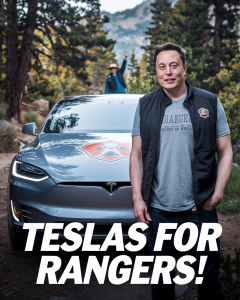
Posts on X reflect a polarized mood. Some users cheer Musk’s resilience, seeing the dip as a buying opportunity for a company poised to dominate autonomy and AI. Others are bearish, citing “unprecedented brand damage” and falling used-Tesla prices as signs of trouble. One post claimed Tesla is “desperately” unloading inventory with cheaper Cybertruck trims, while another speculated Musk is “feeling the repercussions” of his political bets.
Analysts are equally split. Bulls like TD Cowen see a “major 2025-26 product cycle” that could reignite growth, while bears like Wells Fargo warn of further downside if political backlash and trade wars persist. Gary Black of The Future Fund predicts deliveries and profits will “go much lower” without a game-changing new model.
Prediction for Tesla’s Future
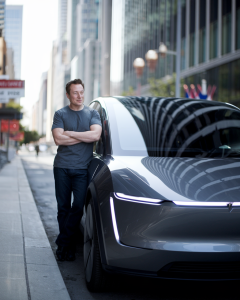
Tesla’s path forward hinges on execution, adaptability, and Musk’s ability to navigate a perfect storm of challenges. Here’s my take on what lies ahead:
Short-Term (2025-2026):
Tesla will likely face continued volatility. Trade wars and brand backlash could keep sales under pressure, with deliveries potentially flat or down for 2025. The stock may test lower levels—possibly $150-$180—if negative sentiment persists or if Redwood’s launch hits snags. However, Musk’s new gigafactory plan and production ramp-up could stabilize investor confidence, especially if tariffs ease or Tesla shifts more manufacturing stateside. A successful Model Y refresh or early Redwood deliveries could spark a rebound, but don’t expect a return to 2024 highs ($400+) anytime soon.
Medium-Term (2027-2030):
Tesla’s long-term edge lies in its tech moat—FSD, battery innovation, and energy storage. If Musk delivers on affordable EVs and robotaxis, Tesla could reclaim its growth narrative. A new U.S. gigafactory would reduce reliance on Shanghai, while expansion in markets like India could offset China’s slowdown. The energy division, with Megapacks powering grids, is a sleeper hit that could rival auto revenue by 2030. That said, competition from BYD and legacy automakers, plus regulatory hurdles for autonomy, will keep the pressure on. I see the stock stabilizing around $250-$300 by 2027, with upside to $500 if FSD hits key milestones.
Risks to Watch:
- Trade Wars: Prolonged U.S.-China tariffs could cripple Tesla’s margins and supply chain.
- Musk’s Brand: Further political missteps could erode Tesla’s appeal, especially in Europe and blue states.
- Execution Delays: Late or overpriced launches (e.g., Redwood, robotaxis) would dent credibility.
- Market Saturation: A global EV slowdown could cap growth unless Tesla cracks mass-market pricing.
Upside Catalysts:
- New Models: A $25,000 EV could unlock millions in sales, especially in Asia and Europe.
- Autonomy Breakthroughs: Regulatory approval for Level 3+ FSD would be a game-changer.
- Energy Growth: Megapacks and solar could become Tesla’s quiet cash cow.
- Tariff Relief: De-escalation between Trump and Xi could lift Tesla’s global ops.

